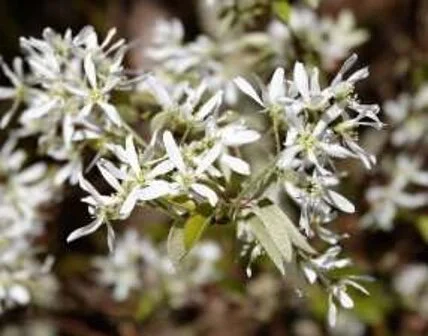Plant of the Month June 2020: Downy Serviceberry
Delicate white flowers brighten the early spring landscape in March.
Serviceberries are one of our loveliest small native trees with multiple seasons of ornamental interest. In the Northern Neck, we have several species found in our area in a range of sizes to fit any garden. Amelanchier arborea, the Downy Serviceberry, is also called Juneberry, Shadblow and Shadbush among other names and is one of the most beautiful and common species. This lovely small deciduous tree typically grows from 15 – 25’ in height but can reach up to 40’ in the wild. Often it is grown as a single trunked small tree but can also be grown with multiple trunks. Serviceberries are one of the earliest trees to bloom in our woodlands and light up the early spring woodlands and river and stream banks with their silky white flowers. In mid to late March the bare branches are covered in slightly drooping clusters of fragrant, pristine white flowers. The flowers are particularly showy framed against the smooth gray bark of the bare branches before the trees have leafed out. The common name Shadblow or Shadbush was given because Serviceberries blooms at the same time as shad ran up our streams and rivers.
Edible ‘Juneberries’ ripen in June and offer tasty sweet treats for both humans and songbirds.
As the flowers begin to fade, finely toothed elliptical blue-green leaves open with downy white hairs on the undersides, giving rise to another common name, Downy Serviceberry. By June, a myriad of small berries ripen from red to a dark purple black, and have a delightful sweet taste similar to blueberries. The berries, while ornamental in themselves, are relished by humans, other mammals and songbirds, and are quickly devoured. They are delicious eaten fresh or used to make jams, jellies, or pies. At least nineteen species of woodland birds relish the summer fruit including grouse, woodpeckers, wood thrushes, red-eyed vireos, scarlet tanagers, baltimore orioles, and rose-breasted grosbeaks. They are also important hosts for the beautiful red-spotted Purple and Viceroy butterflies. Many other butterflies and bees enjoy the early spring nectar of this serviceberry.
Serviceberries turn vivid shades of gold, orange and crimson as the fall season progresses.
In fall, the trees put on another spectacular show, with leaves turning shades of gold, orange, and finally red or burgundy. As the leaves fall, the elegant gray bark and fine branches are beautiful through the winter months. Downy Serviceberries are found in the wild as an understory tree along wooded slopes, bluffs, or in open woods, as well as along river edges or swamp edges. They thrive in both sun and partial shade in both clay and loamy soils. In the garden, they look beautiful planted in naturalistic drifts along woodland edges or under large trees, but they can also make stunning specimen trees, and are equally at home in the edible garden. Try planting early spring bulbs or spring ephemerals underneath to enhance their early spring blooms.
Consider adding this multi-season star to your garden this fall, and enjoy the beauty, edible fruit, and wildlife it will surely attract.
Text and Photos by Betsy Washington



